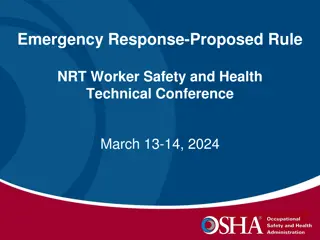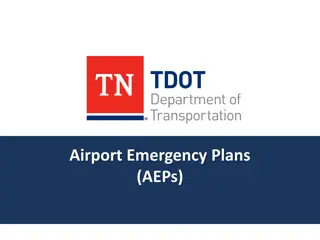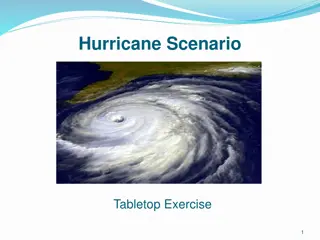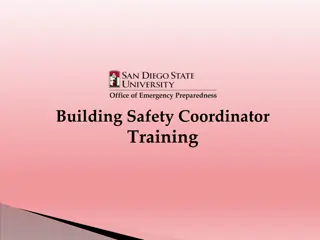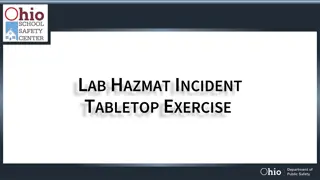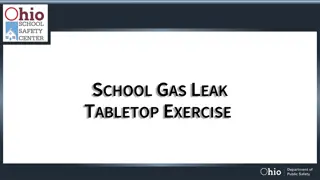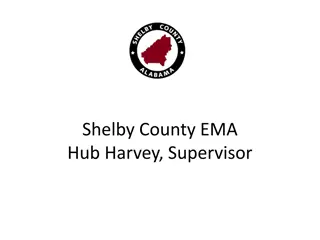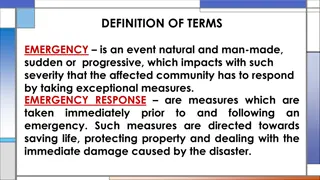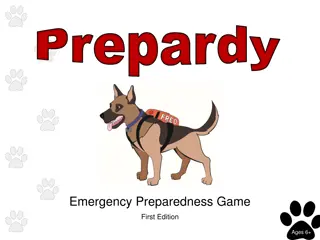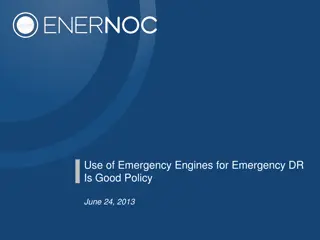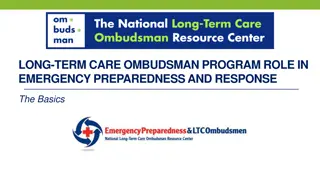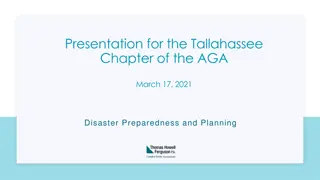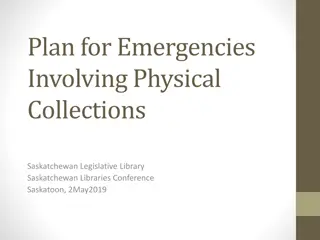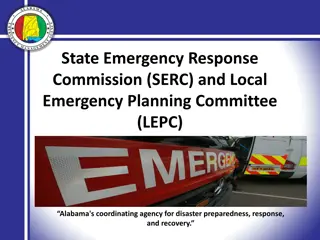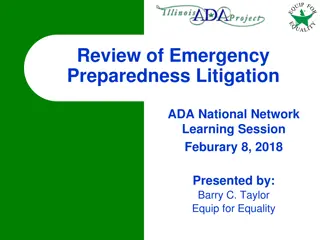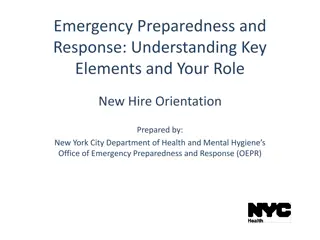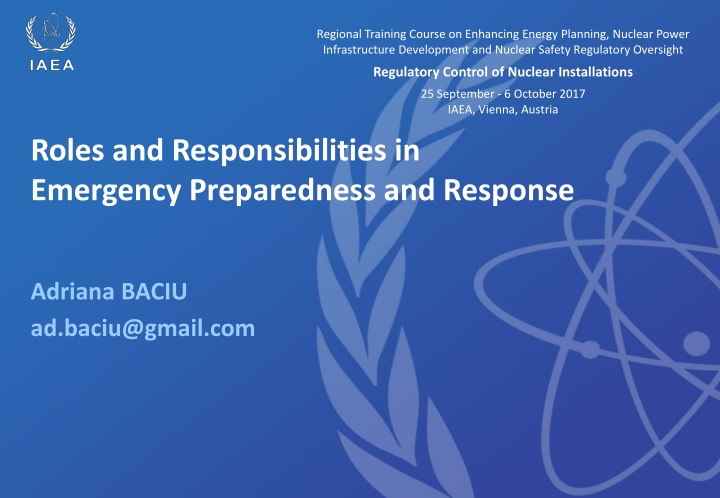
Roles and Responsibilities in Emergency Preparedness and Response
This content delves into the crucial roles and responsibilities in emergency preparedness and response for nuclear or radiological emergencies, covering aspects like government coordination, regulatory oversight, and operational organization cooperation.
Download Presentation

Please find below an Image/Link to download the presentation.
The content on the website is provided AS IS for your information and personal use only. It may not be sold, licensed, or shared on other websites without obtaining consent from the author. If you encounter any issues during the download, it is possible that the publisher has removed the file from their server.
You are allowed to download the files provided on this website for personal or commercial use, subject to the condition that they are used lawfully. All files are the property of their respective owners.
The content on the website is provided AS IS for your information and personal use only. It may not be sold, licensed, or shared on other websites without obtaining consent from the author.
E N D
Presentation Transcript
Regional Training Course on Enhancing Energy Planning, Nuclear Power Infrastructure Development and Nuclear Safety Regulatory Oversight Regulatory Control of Nuclear Installations 25 September - 6 October 2017 IAEA, Vienna, Austria Roles and Responsibilities in Emergency Preparedness and Response Adriana BACIU ad.baciu@gmail.com
Learning objective To understand the roles and responsibilities of the government, the regulatory body, operating organizations and other response organizations for preparedness and response to a nuclear or radiological emergency
Contents Government National Coordinating Mechanism National and Local Authorities Regulatory Body Operating organization Coordination at national and international level Incident Command System Summary Key Points List of abbreviations References
Introduction GSR Part 7, Requirement 2: The government shall make provisions to ensure that roles and responsibilities for preparedness and response for a nuclear or radiological emergency are clearly specified and assigned
Government responsible to: Ensure that an integrated and coordinated emergency management system for preparedness and response for a nuclear or radiological emergency is established and maintained Enact legislation and regulations for EPR in line with international requirements Provide funds and human resources for an efficient response
National Coordinating Mechanism A coordinating mechanism should be established at national level Appointed by the Government Responsible to coordinate the preparedness activities at national level One single national authority e.g. Disaster Management Organization or An inter-agency mechanism composed by national authorities e.g. a committee consisting of representatives from different organizations
Discussion Who in your country plays the role of National Coordinating Mechanism?
National officials Governmental authorities responsible for planning and response at national (or regional) level Usually perform tasks such as: - long term protective actions - support of local officials in the event that their capabilities are exceeded In some cases they may have role also in the urgent phase of an emergency
Local officials Governmental authorities and support agencies responsible for: Immediate support to the operator and Prompt protection of the public Include: Civil emergency services Police Fire fighting and Medical personnel It may include officials from different States, if the facility is near the border (EPC V)
National and local officials Establish and maintain arrangements for preparedness and response Demonstrate effectiveness of emergency arrangements Coordinate the off-site response with the on-site response, ensure harmonization of response within the national system
Dual role of the Regulatory Body (RB) As REGULATOR To regulate, authorize and control facilities and activities in the nuclear field As RESPONSE ORGANIZATION To provide advice and expert services on EPR at national level To coordinate preparedness with the National Coordinating Mechanism
RB as REGULATOR Establish regulations EPR requirements for operating organizations consistent with GSR Part 7 Authorize Establish an authorization system Provide reasonable assurance for adequate EPR arrangements Verify Establish an inspection system Check the compliance of EPR arrangements for all licensees Systematic evaluation of on-site exercises
RB as RESPONSE ORGANIZATION Preparedness Supports the development of the national emergency response framework Supports and coordinate with other competent authorities in all preparedness activities Response Advise the government and competent authorities Provide expert services As stipulated in the national emergency response framework This role is specific to each Member State
RB as RESPONSE ORGANIZATION examples: Notification and Information Exchange (NCA(A), NCA(D), NWP as per Assistance Convention) Radiological consequences assessment protective actions for workers and public Nuclear safety assessment facility status, evolution and prognosis Public information Radiation monitoring On-scene response (EPC IV) response roles are specific to each Member State
Discussion What roles has the RB in your country for emergency preparedness and response?
Operating organizations: responsibilities for preparedness Establish and maintain arrangements On-site preparedness and response for facilities or activities under their responsibility, in line with regulatory requirements Demonstrate that emergency arrangements are in place for an effective response on the site Co-ordinate and integrate the on-site arrangements With the off-site arrangements existing at local and national level
Operating organizations: responsibilities during response phase taking immediate actions to mitigate the emergency; protecting people on the site; notifying off-site officials and providing them with recommendations on protective actions and technical assistance; warning the public within the emergency planning zones (EPC I and EPC II) providing initial radiological monitoring keeping the public informed
Coordination at national level Coordinate planning and preparedness activities Coordinate emergency arrangements: arrangements and protocols for operational interfaces arrangements to develop and harmonize tools, procedures or criteria for use in the response to nuclear or radiological emergency arrangements to harmonize radiation monitoring arrangements to harmonize assessments of contamination, doses and radiation induced health effects Coordinate building infrastructure to support the response functions
Incident Command System (ICS) Is a standardized, on-scene, all-hazards incident management structure Based on unified command and control concept Allows for the integration of facilities, equipment, personnel, procedures and communications within a structure Enables a coordinated response among various jurisdictions and functional agencies Establishes common processes for planning and managing resources
An ICS is used for all types of emergencies Radiological / Nuclear Fires Earthquakes Flooding Wind Terrorist attacks
ICS includes all stakeholders All levels Operating organizations Local and national governments Non-governmental organizations All necessary specialists Radiological assessors Social services Law-enforcement Other elements of the response
ICS uses: Common terminology Modular organization Integrated communications Designated facilities/locations Uses unity of command
Coordination at international level Arrangements and protocols with other States to Coordinate early notification, data and information exchange Public information Protective actions Special arrangements for States with areas in category V Early notification and information exchange Radiation monitoring Protective actions
Summary Roles and responsibilities for EPR have to be clearly defined into the national legislation for all stakeholders in a State: national coordinating mechanism, local and national authorities, regulatory body, operating organizations All response organizations have to establish and maintain arrangements for EPR and coordinate them within national system and at international level Integration and coordination of emergency arrangements and capabilities have to be established at the preparedness stage
Key Points A National Coordinating Mechanism should be established Responsible for emergency preparedness activities at national level Regulatory Body has dual role in relation to EPR: As regulator As response organization An ICS is a standardized, on-scene, all-hazards incident management structure for response coordination Based on unified command and control concept
List of abbreviations EPR emergency preparedness and response RB regulatory body NCA(A) National Competent Authority for Accidents Abroad NCA(D) - National Competent Authority for Domestic Accidents NWP National Warning Point EPC emergency preparedness category GSR General Safety Requirements IAEA International Atomic Energy Agency ICS Incident Command System UC Unified Command
References IAEA GSR Part 7 IAEA GS-G-2.1 (2007) IAEA EPR-Method (2003) IAEA EPR-First Responders (2006)
Regional Training Course on Enhancing Energy Planning, Nuclear Power Infrastructure Development and Nuclear Safety Regulatory Oversight Regulatory Control of Nuclear Installations 25 September - 6 October 2017 IAEA, Vienna, Austria Any questions? Thank you!

